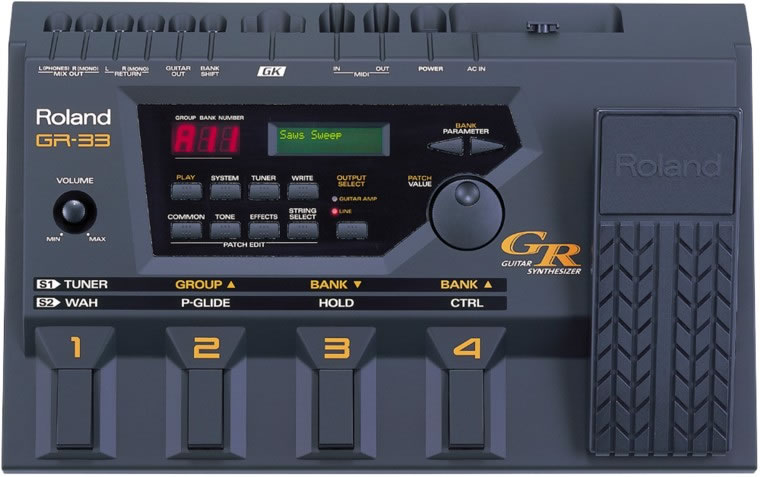Roland GR-33 Guitar Synthesizer Review
Contents
- 1 Review or Comparison of multiple products
- 2 Identify the product - Make, Model, List Price, Typical Street Price
- 3 Setup Instructions
- 4 Essential Synth jargon
- 5 Interaction with the L1
- 6 Application
- 7 How Testing was done
- 8 General Comment
- 9 What do I like about the product
- 10 What I do not like about the product
- 11 Quality Rating
- 12 Review Summary
- 13 Review Date
Review or Comparison of multiple products
- Review of one product
Identify the product - Make, Model, List Price, Typical Street Price
- Roland GR-33 - Guitar Synthesiser paid $1200 (Australian Dollars) in 2003
What can you do with this gadget?
This is a variation on the FX foot pedal theme
- Play solos using syth sounds (eg: trumpets, violins, mizmars, space vox etc)
- Double your sound with synth sounds plus your guitar
- create and edit your own patches
Features
- 384 tone palette
- 128 preset patches
- expression pedal
- onboard tuner
- MIDI In/Out
- Multi-FX
- arpeggiator
- harmonist
Setup Instructions
Firstly the synthesiser requires a hexophonic pickup system on the guitar to operate. You can do this by mounting a Roland GK series pickup on your existing electric or steel string acoustic guitar. I use a Godin “synth acess” guitar which has a hexophonic pickup built-in.
This setup is for using the GR33 with a T1 ToneMatch Audio Engineusing the supplied 13-pin cable connect your guitar to the GR-33.
I like to have separate control of my sythn sound and my guitar sound, so I use the GR33’s GUITAR OUT to channel 1 of the T1 ToneMatch Audio Engine; and the GR-33 MIX OUT (R MONO) to channel 2 of the T1 ToneMatch Audio Engine. For the T1 ToneMatch Audio Engine presets, I use my favourite accoustic guitar preset for channel 1 and for the GR-33 in channel 2 I use DJ/Playback-Low Volume music.
Essential Synth jargon
- Tone: raw sound sample eg: GR piano, Jazz Organ 1, Oboe, Trumpet Ens,
- Patch: up to two tones layered together with effects applied ; eg Romantic Pad Asian Bells, Digi Choir
- attack: time it takes the tone to swell to its highest volume
Interaction with the L1
Since the L1 is so transparent, care must be taken with gain staging process your choice of patch for gain staging is important. Pick a patch where both tones attack is zero so that the highest volume is at the beginning of the note. Sounds so logical doesn’t it…… but I have been caught out in performances with pad type patches that swell and develop and overwhelm the song.
Using the compressor on the T1 ToneMatch Audio Engine may help.
With the gain staging set right, the sound of the you will be in sonic heaven and the capabilities of the GR-33 and the L1 will amaze. But beware ….if you are performance- wise with the GR-33 on other amps and PA’s do not assume the patches will behave for you on the L1 as for other systems. Test every GR-33 patch with the L1 before you hit the stage or you may end up with nasty surprise.
For eg: GR-33 patch C84 – Phaser Str2 contains a phaser sweep tone that reaches deep bass tones that may not have been audible on other systems that don’t have the range of the B1 Bass Module.
Application
Used in the following applications, your results should be very sweet..... Try this experiment – playing a well known Christmas song “Jingle Bells” at a sing-along can sound pretty dull just strumming or flat picking a guitar. But try adding GR-33 syth patch C51-AIR BELL PAD on a L1 with gainstructure set as above.
How Testing was done
A disclaimer, this was done in informal... Physical surroundings: the room was a 4.5m x 3.5m room back room converted to a “studio”. Testing was done to correct specific live performance goofs which surfaced after switching to the L1 .
General Comment
This is a significant improvement because now when connected the L1 for the 1st time do I have sufficient control over the GR-33 guitar synth in a live situation.
Because of past disappointment in live shows using the GR-33 through acoustic guitar backline amps where I couldn’t be heard due to audience attenuation, I had limited the use of the GR-33 to solo gigs in small venues. I now wonder how the GR-33 L1 will do in small band situations.
What do I like about the product
I love the idea of guitar syths and sound doubling because it makes my solo sound much bigger and the combined sound appeals to more people.
What I do not like about the product
The 13-pin connector is a definite weak point. It is fragile and can be the source of crackling noise if any strain is placed on it.
Quality Rating
5/10 It has a rugged build quality. My GR-33 has survived 50 odd gigs and almost constant home use in nearly six years.
Review Summary
I've never tried any other guitar synth. I will always own a guitar synth and will try any brand comes available. I will definitely buy a replacement of the best brand when this one dies. The down side is that because of the 13pin connector I will probably have to buy a new guitar with it. Great sound but not very “future proof”.
Review Date
2008-09-07
